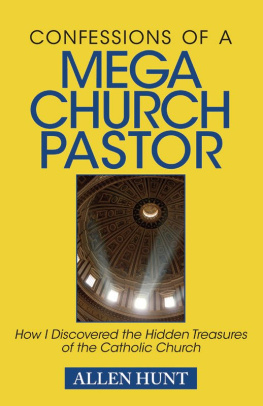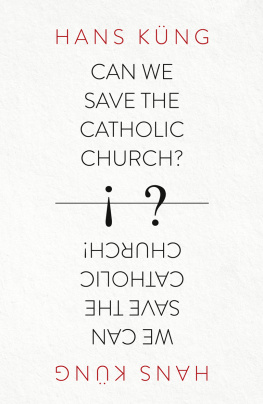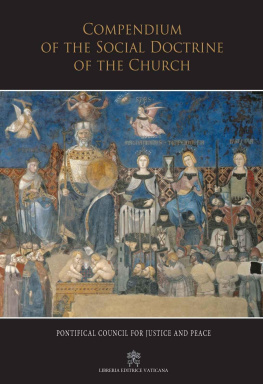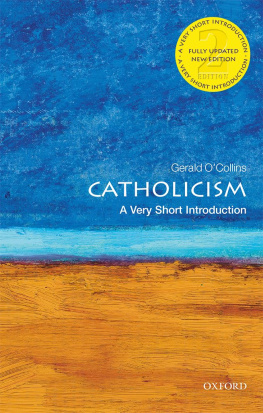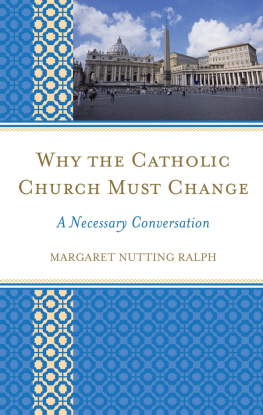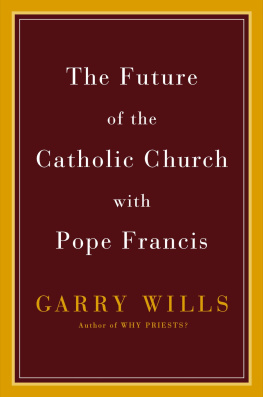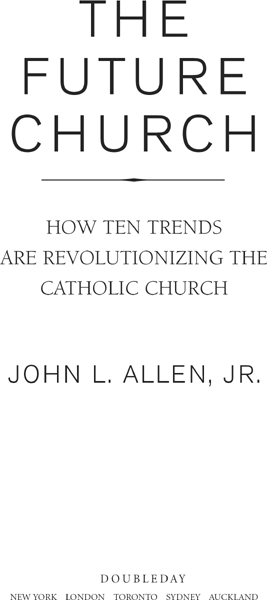ALSO BY JOHN L. ALLEN, JR.
Conclave
All the Popes Men
The Rise of Benedict XVI
Opus Dei
ACKNOWLEDGMENTS
I want to begin by acknowledging Trace Murphy, my editor at Doubleday, and Bill Barry, who was the publisher at the time this project took shape. Both are a writers dream, literary professionals who care deeply about ideas as well as helping a book find its audience. Theyre extraordinarily good at what they do. Thanks are also due to everyone at the National Catholic Reporter, which has been my home in the print world for more than a decade. Tom Fox, Tom Roberts, Joe Feuerherd, Dennis Coday, Teresa Malcolm, Margot Patterson, Sr. Rita Larivee, Patty McCarty, Wally Reiter, Toni Ortiz, Arthur Jones, Rich Heffern, and all the other past and present members of the NCR cast have been marvelous friends and colleagues. Im especially appreciative of their tolerance for my absences to do the reporting and writing this book required. In a similar spirit, I want to thank my friends and colleagues at CNN, especially my principal contacts over the years: Pamela Sellers, Maria Ebrahimji, and Gail Chalef. In moments of frustration Ive sometimes joked that navigating the bureaucracy of CNN can make the Vatican seem like a well-oiled machine, and without Pam, Maria, and Gail, I would have been lost on any number of occasions. In terms of my colleagues in the Vatican press corps, if I started to tick off here the names of everyone to whom this book owes something, the list would never end. Suffice it to say that you know who you are, and Im grateful.
Chapters of this book were read and critiqued by a number of people who deserve mention here: Cardinal scar Rodrguez-Maradiaga of Tegucigalpa, Honduras; Cardinal Roger Mahony of Los Angeles; Archbishop John Onaiyekan of Abuja, Nigeria; Bryan Froehle; Philip Jenkins; George Weigel; Fr. Thomas Reese; Fr. Andrew Greeley; Fr. Daniel Madigan; Fr. Emmanuel Mbam; Russell Shaw; Rick McCord; Walter Grazer; Fr. Brian Johnstone; Fr. Edward Cleary; Fr. John Wauck; Pamela Schaeffer; and Tom Roberts. In every case, their reactions were extraordinarily helpful. Froehle in particular was generous with his time and expertise. Needless to say, the flaws in the book are of my own making, not theirs. My wife, Shannon, also read every line of this book at least twice, and along the way she fed me valuable ideas and resources. This book would never have seen the light of day without her support.
I also want to say thank you to those readers who sent me ideas, arguments, exhortations, and detailed reactions. That material was fundamental in shaping the decisions and the perspectives that run through the book. In a special way, I need to acknowledge a debt of gratitude to the audiences in various parts of the world with whom the ideas of this book were worked out during lectures, keynote speeches, workshops, and addresses Ive given over the last couple of years. You will never know how much watching the reaction on your faces, listening to how hard you laughed at various points, and pondering the questions you had asked long after I had answered them on the spot have contributed to these pages.
A final note of thanks is in order for all those people in forty countries who have opened their lives, their minds, and their hearts to me over the course of the past decade, giving me an up-close-and-personal education in the contours and complexities of global Catholicism. In a special way, I want to think Cardinal Rodrguez and Archbishop Onaiyekan, each of whom opened his diocese and cleared his schedule for me in March 2007 to help test some of the ideas Id developed about Catholicism in the global South against the realities on the ground. To both, a hearty ad multos annos.
A book freezes an authors thinking at a given moment in time. To follow the conversation beyond these pages, I invite readers who have not yet done so to sign up for my weekly Internet column, All Things Catholic, and to check out my daily postings at this address: http://ncrcafe.org/node/507. Ill be keeping a close eye on the evolution of the trends described here.
This book is dedicated to my wife, Shannon, whose love constitutes the most powerful trend in my own life, and to our cherished pug, Ellis, a very catholic creature in terms of the universality of his affections. Both endured the long gestation of this book with grace, for which I will be forever grateful.
INTRODUCTION
I n Thomas Friedmans enormously popular book about globalization, he summarized the essential message in four words: the world is flat. Globalization is knocking down one barrier to opportunity after another, creating a world in which smart, hungry go-getters in India, China, or Brazil can compete not just for the low-wage jobs Americans dont want, but for the high-tech, high-pay jobs they definitely do want. For that reason, Friedmans book came with a warning: Americans need to hustle in this century or theyll find themselves run over by this phenomenon.
This too is a book about globalization. Its subject is the oldest globalized institution on earth, the Roman Catholic Church. Its bottom line can also be expressed in a few words: the church is upside down. By that, I dont mean that the Church is topsy-turvy or out of whack. I mean that the issues, party lines, and ways of doing business that have dominated Catholicism in the forty-plus years since the close of the Second Vatican Council in 1965, that watershed moment in modern Catholic life, are being turned on their head by a series of new forces reshaping the global Church. This book comes with a warning too: Catholics in the twenty-first century wont just need hustle (though they certainly will need that), but above all theyll need imagination. Theyll need the capacity to reconsider how they think about the Church, and what they do with their faith, because otherwise Catholicism wont rise to the occasion of these new challengesitll be steamrolled by them.
Consider the following ways in which the Catholic Church is upside down in the twenty-first century:
A Church dominated in the twentieth century by the global North, meaning Europe and North America, today finds two thirds of its members living in Africa, Asia, and Latin America. Catholic leadership will come from all over the world in this century to a degree never before experienced.
A Church whose watchword after the Second Vatican Council (196265) was aggiornamento, meaning an updating designed to open up to the modern world, is today officially reaffirming all the things that make it different from modernity: its traditional markers of Catholic thought, speech, and practice. This politics of identity is in part a reaction against runaway secularization.
A Church whose primary interreligious relationship for the last forty years has been with Judaism now finds itself struggling to come to terms with a newly assertive Islam, not just in the Middle East, Africa, and Asia, but in its own European backyard.
A Church that has historically invested a large share of its pastoral energy in the young now has to cope, beginning in the North, with the most rapidly aging population in human history.
A Church that has long relied on its clergy to deliver pastoral care and to provide leadership now has lay people doing both in record numbers and in a staggering variety of ways.



